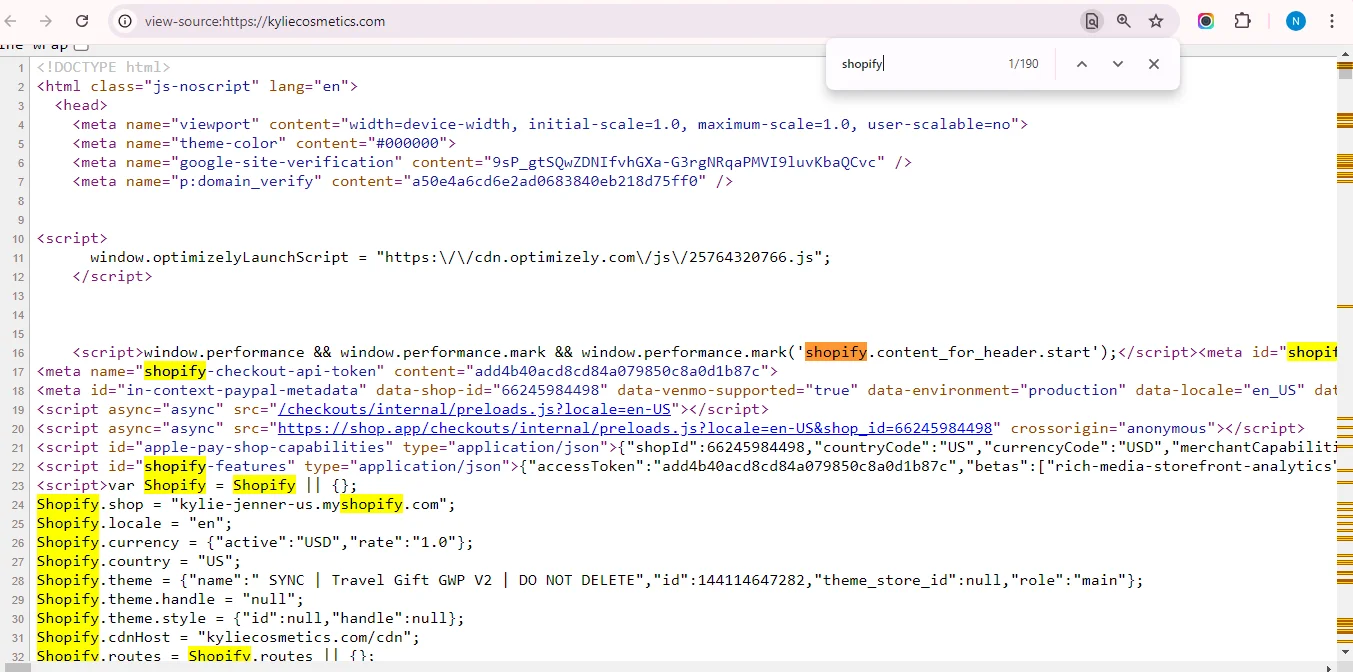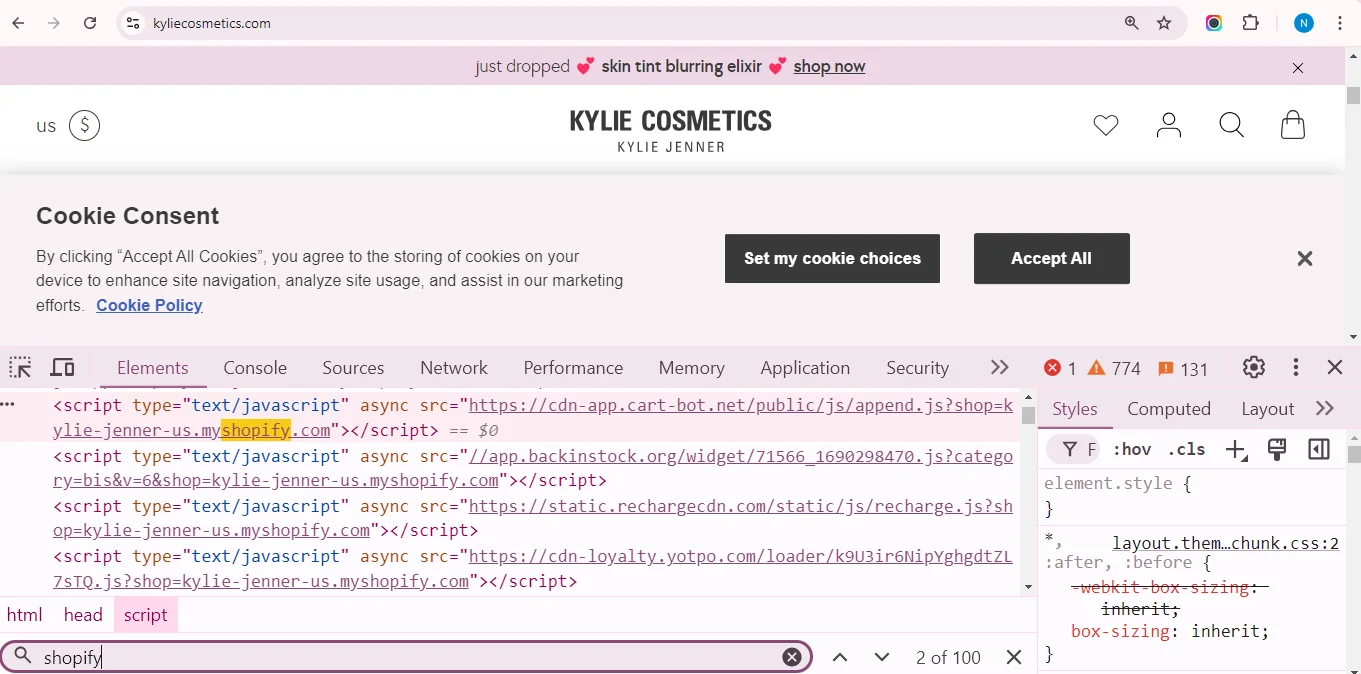How to Tell If a Site is Using Shopify in 5 Seconds

Shopify has taken the e-commerce world by storm, fueling numerous online stores across the globe. Whether you’re a tech enthusiast, a marketing guru, or just love to shop online, uncovering if a website runs on Shopify can be quite insightful.
In this guide, we’ll walk through some quick and easy ways to figure out if a website is built by Shopify.

Why It’s Useful to Know if a Website Uses Shopify
Understanding the platform behind a website can be beneficial for several reasons:
- For businesses and competitors, it can offer insights into the tools and functionalities that other stores are leveraging.
- For developers and designers, knowing the platform can help in planning integrations or design strategies.
- For consumers, it can provide an idea of the site’s reliability and the kind of customer experience to expect.
Methods to Confirm If a Site Uses Shopify

Examining the Website’s URL Structure
One of the easiest ways to determine if a website uses Shopify is by inspecting its URL structure. Many Shopify-powered websites use specific URL patterns that include keywords such as collections, products, or pages. For example, a Shopify website might have a product URL that looks like this:
https://www.example.com/products/t-shirt
or a collection URL like:
https://www.examplestore.com/collections/summer-sale
However, it is important to note that this method is not always reliable. Some websites that are not powered by Shopify may also use similar URL structures.
Looking for Shopify Indicators in the Page Source Code
Another effective method is to check the page source code for Shopify-specific tags and indicators:
View page source or check site elements:
- Method 1: View page source: Access the website’s code by right-clicking anywhere on the page and selecting View Page Source or pressing Ctrl + U.
- Method 2: Check site elements: Right-click anywhere on the page and choose Inspect
Search for “Shopify”: Within the code, use the search function (usually Ctrl + F) to see if “Shopify” appears. This might indicate the presence of Shopify scripts or libraries.


Using Browser Extensions and Online Tools
Several browser extensions and online tools can help you identify Shopify-powered websites. These tools use various techniques, such as analyzing the website’s source code and URL structure, to determine the underlying platform.
Here are a few popular browser extensions and online tools that can help you identify Shopify websites:
-
Wappalyzer: This browser extension identifies the technologies used to build a website, including the e-commerce platform.
-
BuiltWith: This online tool provides detailed information about the technologies used on a website, including the e-commerce platform.
Spotting Shopify-Specific Features
Shopify stores often have distinctive features and characteristics:
-
Checkout Page: The checkout process on a Shopify store often follows a specific pattern. If you add a product to your cart and proceed to checkout, the layout and steps involved can be a telltale sign. Shopify’s checkout pages tend to have a consistent structure, even if the store’s overall design is unique.
-
Subdomains: While less common these days, some older Shopify stores might still be using a subdomain like storename.myshopify.com. If you spot a subdomain with “myshopify” in it, it’s a surefire sign that the site is built on Shopify.
-
Shopify Admin Bar: This is a more exclusive method, applicable only if you have access to a Shopify store’s admin panel. When logged in as an administrator, a toolbar might appear at the bottom of the browser window when you visit the store’s frontend. This toolbar provides quick access to the admin panel and confirms the use of Shopify.
SEO Patterns and Structured Data Examination
Shopify websites often follow specific SEO patterns and use structured data markup to improve their search engine ranking. Look for the following clues:
- Meta tags: Find shopify:digital-wallet or shopify:domain for example, these values indicate basic Shopify usage
- Structured data: Shopify websites often use structured data markup to provide information about products, brands, and other entities to search engines.
Conclusion
Identifying whether a website is built on Shopify isn’t just a matter of curiosity. It can provide valuable information for competitors, affiliate marketers, developers, and even customers. By using a combination of the methods described in this article, you can become adept at spotting Shopify stores and use that knowledge to your advantage.
Remember, while these methods are generally reliable, some store owners may customize their Shopify themes or use techniques to obscure the platform. Therefore, it’s advisable to use multiple methods to confirm your suspicions.
FAQs
Q1: Can I use this information to access a Shopify store’s backend?
A1: No, identifying a website as Shopify doesn’t grant you access to its backend or any private information. This information is solely for observational purposes.
Q2: Are there any risks in trying to identify a Shopify store?
A2: The methods described here are generally safe and non-intrusive. However, be mindful of respecting website owners’ privacy and avoid any actions that might disrupt their operations or violate their terms of service.
Q3: Can Shopify stores be completely hidden from detection?
A3: While it’s possible to customize a Shopify store to obscure its platform, it’s unlikely to completely hide all traces. Experienced observers can often find clues through careful examination.
Q4: Can I identify a Shopify store just by looking at its design?
A4: While Shopify offers a wide range of themes, some design elements might be indicative of a Shopify store. Look for clean layouts, minimalist aesthetics, and common features like prominent search bars or product image zoom functionalities. However, this isn’t a foolproof method, as stores can heavily customize their themes.
Q5: Why should I care if a website uses Shopify?
5: Knowing the platform can help in understanding the site’s capabilities, planning integrations, and assessing the overall reliability of the online store.






![Top 20+ Must-have Shopify Apps for 2025 [Free & Paid] - Mageplaza](https://cdn2.mageplaza.com/media/blog/must-have-shopify-apps/top-must-have-shopify-apps.png)
![[2025 Updates] Top 10+ Upsell Apps for Shopify - Mageplaza](https://cdn2.mageplaza.com/media/blog/best-upsell-shopify-app/cover.png)